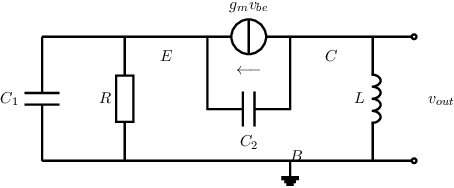An answer:

An answer:
The loop gain equals 1; this is used in the derivations below.
An answer:
The loop gain equals 1 at the oscillation frequency. This oscillation frequency follows from
equating the loop gain to a real value. To derive the loop gain: the best way is to cut the loop
inside an abstract controlled block. In this schematic the only abstract controlled block is the
SSEC of the transistor.
At oscillation, this which can be expanded as e.g.:
Collecting the imaginary terms and equating these to zero yield
An answer:
Recycling the previously found equations for loop gain, and equating that to 1 at
(note that this implies that you only have to take the real terms into account) this yields: